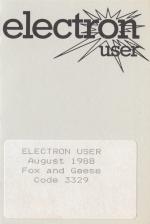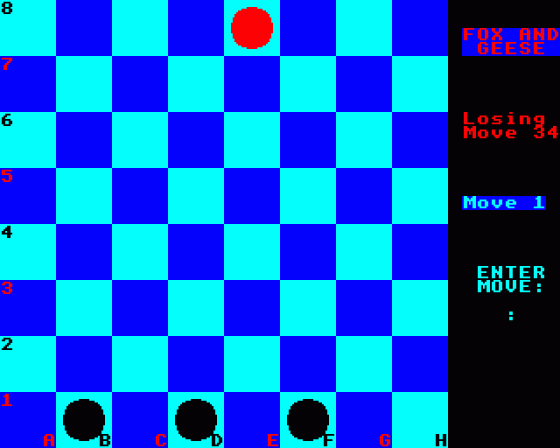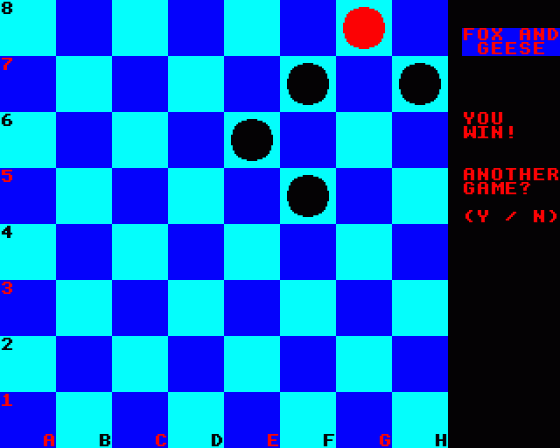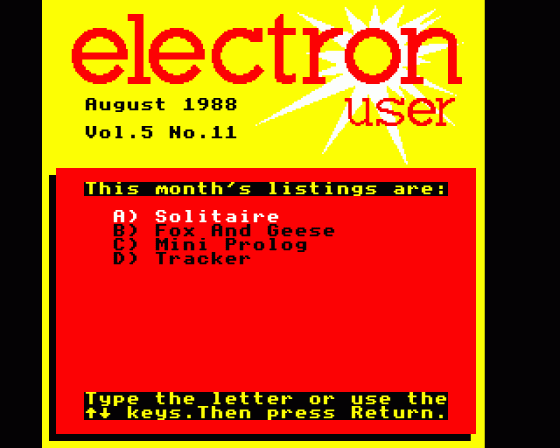
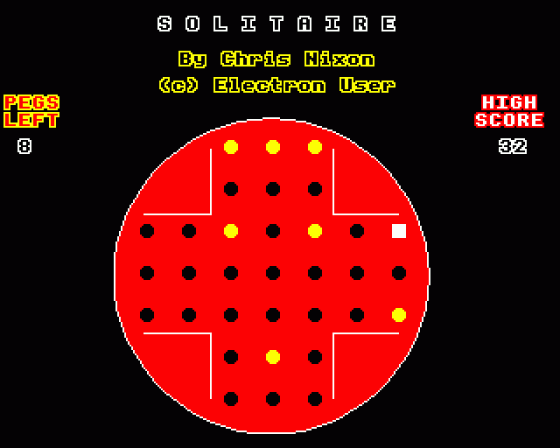
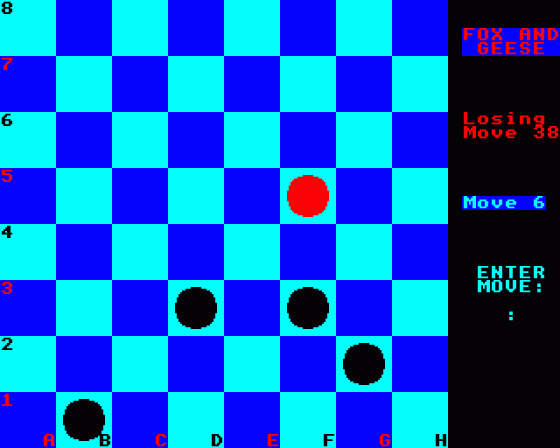

| Genre: | Compilation Of Arcade Games |
| Publisher: | Database |
| Contents: | |
| See Also: | The programs on this Cassette were supplied in type-in format in the magazine Electron User 5.11. |
| Cover Art Language: | English |
| Machine Compatibility: | Acorn Electron |
| Release: | on Cassette |
| Compatible Emulators: | Elkulator 1.0 (PC (Windows)) |
| Original Release Date: | 1st August 1988 |
| Original Release Price: | Unknown |
| Market Valuation: | £2.50 (How Is This Calculated?) |
| Item Weight: | 64g |
| Box Type: | Cassette Single Plastic Clear |
Variant Items
There are 0 other items featuring this same game (that we know about!). Click any of them for their details.
Active Auctions
Closed Auctions
Buy It
Unfortunately no-one is currently selling this item.
Auction Price Watch
Worried you're being ripped off? Closing prices on eBay can help you decide what a reasonable price is for a particular item.
Full Instructions
FOX AND GEESE
Fox your Electron in this classic board game by Chris Nixon
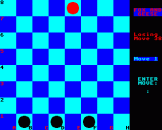 FOX AND GEESE is a computerised version of the popular board game, but with one or two enhancements.
FOX AND GEESE is a computerised version of the popular board game, but with one or two enhancements.
One player takes the part of the goose, represented by a white pawn, while a second player controls four foxes, represented by black pawns.
The object is simply to prevent the goose from breaking through the line of foxes and reaching the other side of the board.
The goose starts at the top of the board, and the foxes start on the last row at the bottom.
If the four foxes manage to corner the goose so that it cannot move, you have won the game.
In this computerised version, the Electron takes the goose's part, and you have to prevent its passage across the board.
Moves are very simple - all pieces can move just one square diagonally, but the foxes cannot normally move backwards. The first variation in this version is that you will lose by default if you fail to trap the goose within a set number of moves.
This limit on moves is chosen at the start of each game by selecting a difficulty level between one and five. One represents a maximum of thirty moves - for a relatively easy game - which five allows you only 20.
The second difference is that you have a choice as to whether your foxes can move forwards only, or backwards as well.
Purists may scoff at this option, but it provides more variety, and at the same time makes the game easier for younger children.
Furthermore, the number of foxes in play may be set to either three or four, providing yet another level of difficulty. These three options together allow the game to be better matched with individual playing skills.
Once your choices are made, the board will be drawn and the maximum moves allowed displayed. You will then be asked for your first move.
Input is made in the same way as with modern chess computers, that is, a grid reference system is used where a letter and number represent the horizontal and vertical position of the target piece.
To make this easier, the bottom row of the board is marked with the letters A to H, and the left-hand column with the numbers one to eight. Enter the letter representing the piece's column first, followed by the row number.
There is no need to press RETURN after each entry, as the keyboard is read using the GET function. The Electron will reply very quickly to your move, and will check at this point whether it has been successfully hemmed in.
It it has, the game will be awarded to you. Otherwise, it moves the goose and checks to see whether it has reached the far edge of the board yet. If so, you lose.
Nine separate rules are built into the goose's strategy, and you may be surprised as to just how wiley it can be. The rules tell it to avoid obvious traps, but if you are patient and devious, you can surprise it.
SOLITAIRE
SOLITAIRE has always been one of my favourite puzzles. Unlike some other patience-type games usually involving cards, it never seems to lose its attraction.
 It comes in a variety of forms, ranging from a large plastic dish with depressions in which you place marbles, to small pocket sets which use plastic pegs.
It comes in a variety of forms, ranging from a large plastic dish with depressions in which you place marbles, to small pocket sets which use plastic pegs.
Here is yet another version of Solitaire, this time in a computerised form to allow its many delights and frustrations to be experienced on your Electron.
The idea is simple. You fill the board with 32 pegs, but leave the middle hole empty. Then each peg must be removed by jumping an adjacent peg over it into an empty hole.
| Variables | |
| board%() | Holds peg positions |
| XM% | Cursor X coordinate |
| YM% | Cursor Y coordinate |
| OX% | Peg X coordinate |
| OY% | Peg Y coordinate |
| X1% | New peg X coordinate |
| Y1% | New peg Y coordinate |
| B% | High score |
| M% | Number of remaining pegs |
|
Procedures |
|
| setup | Initialise game |
| newgame | Start new game |
| board | Draw the pegs |
| play | Move a peg |
| score | Print remaining pegs |
| hiscore | Print high score |
| text | Print outlined text |
To solve the puzzle properly, the last peg must end up in the centre hole, which was left empty at the start of the game. But this is not as easy as you might think.
I have never, in more than twelve years, managed to complete Solitaire properly. The best I have ever managed is to get down to the last peg. Perhaps that just says something about my brain power, or rather lack of it.
Mind you, I never tire of trying to find that elusive sequence of moves which will lead to the solution. And now you can try it too, but don't blame me if you get frustrated - the author cannot accept responsibility for any dented or flattened Electrons resulting from usage of this program.
When you run the program the screen will go blank for a short while before the board appears. This delay might seem rather long if you don't have a Turbo board fitted, but it's actually only about thirty seconds.
When the board appears, you will see the number of pegs remaining displayed at the top left of the screen. This is initially 32, and will drop with each peg taken.
At the top right of the screen is the high score tally. When you get stuck - that is, no more pegs can be taken - pressing Q will reset the board ready for a new game, and update the high score if you managed to remove more pegs than the number shown.
To remove a peg, place the white square cursor over an adjacent peg and press RETURN. Then move the cursor two positions in any direction to an empty hole, so that there is a peg between the cursor's position and the peg you are moving.
You will see that the peg you selected has turned white, and will stay this colour until you press RETURN to move it to its new position. The middle peg will vanish from the board, and the peg indicator at the top left of the screen will drop by one.
If you select a peg which is physically impossible to move, due to there being no empty hole for it to land in, press the SPACE bar to deselect it. This is necessary because the program doesn't check whether a selected peg can jump over another or not until you actually try it.
The computer will award a win if you manage to get down to the last peg - I felt it was too mean to insist that it should end up in the middle hole as well.
Game Controls:
Cursor Keys to move, RETURN to select/place peg, SPACE to deselect
Q - Quit
Screen Designers
The following utilities are also available to allow you to edit the supplied screens of this game:
Cheats
Download
A digital version of this item can be downloaded right here at Everygamegoing (All our downloads are in .zip format).
| Download | What It Contains |
|---|---|
| A digital version of Electron User 5.11 suitable for Elkulator 1.0 (PC (Windows)) | |
| A digital version of Electron User 5.11 suitable for Elkulator 1.0 (PC (Windows)) |
Report A Problem
We thank you from the bottom of our hearts if you report something wrong on our site. It's the only way we can fix any problems!
You are not currently logged in so your report will be anonymous.
Add Note
Release Country
Change the country to update it. Click outside of this pop-up to cancel.
Scan Of Selected Article
If you auction an item, it will no longer show in the regular shop section of the site.

